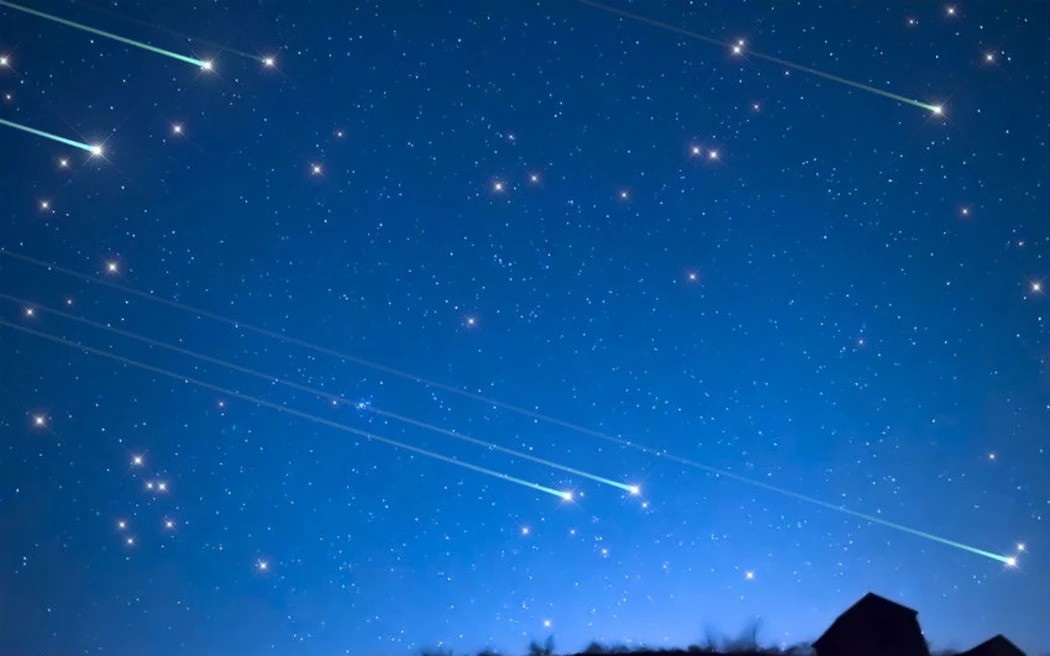Two meteor showers are due to reach their peak around 31 July. File picture. Photo: 123RF
题图:两场流星雨将在7月31日左右达到顶峰。档案图片。照片:123RF
On any clear night, if you gaze skywards long enough, chances are you’ll see a meteor streaking through the sky. Some nights, however, are better than others.
【澳纽网编译】在任何晴朗的夜晚,如果你凝视天空足够长的时间,你很可能会看到一颗流星划过天空。然而,有些夜晚比其他夜晚更好。
广告 | Advertisement
在澳纽网做广告 | Advertise with us
At certain times of year, Earth passes through particularly dirty parts of its orbit, ploughing through debris left behind by comets and asteroids. During those times, we see that debris crashing into our atmosphere, and a meteor shower is born.
在每年的某些时候,地球会穿过其轨道上特别肮脏的部分,犁过彗星和小行星留下的碎片。在那些时候,我们看到碎片撞击我们的大气层,流星雨诞生了。
Some meteor showers are better than others. The faster the debris is travelling, or the more debris there is, the more meteors you will see. But generally, these showers are annual events – recurring whenever Earth returns to the same place in its orbit.
有些流星雨比其他流星雨更好。碎片行进的速度越快,或者碎片越多,你看到的流星就越多。但一般来说,这些流星雨是一年一度的事件——每当地球返回到其轨道上的同一位置时,就会反复发生。
The end of July is one such time, with Earth going through several swathes of our Solar System’s debris at once.
七月底就是这样一次,地球同时穿过我们太阳系的几个碎片带。
Two of those showers reach their peak around 31 July. While neither ranks among the very best showers of the year, taken together the two can put on a lovely show in the depths of our cold winter nights.
其中两场阵雨在7月31日左右达到高峰。虽然两者都不是一年中最好的流星雨之一,但两者结合在一起可以在我们寒冷的冬夜深处上演一场可爱的表演。
Earth orbiting around the Sun (blue circle) and intersecting with the two debris streams: Alpha Capricornids in pink and Southern Delta Aquariids in yellow. Video created on an Evans & Sutherland Digistar 7 system by Museums Victoria.
地球围绕太阳运行(蓝色圆圈),并与两条碎片流相交:粉红色的摩羯座α流星雨和黄色的宝瓶座南三角洲流星雨。在维多利亚博物馆的Evans&Sutherland Digistar 7系统上创建的视频。
广告 | Advertisement
在澳纽网做广告 | Advertise with us
The Southern Delta Aquariids: the fast ones
南方三角洲宝瓶座流星雨:最快的
The first, and most active, of the two showers is the Southern Delta Aquariids. For stargazers in Australia and New Zealand, they are the third-strongest meteor shower of the year (after the amazing Geminids, in December, and the Eta Aquariids, which peak in early May).
两个流星雨中的第一个,也是最活跃的是宝瓶座南部三角洲流星雨。对于澳大利亚和新西兰的观星者来说,它们是一年中第三强的流星雨(仅次于12月令人惊叹的双子座流星雨和5月初达到顶峰的宝瓶座η流星雨)。
The Southern Delta Aquariids are dust from comet 96P/Machholz – a dirty snowball that moves on a highly elongated and tilted orbit within the inner Solar System. 96P/Machholz is the largest object in a broad stream of debris which produces several meteor showers throughout the year.
宝瓶座南三角洲流星雨是来自彗星96P / Machholz的尘埃 – 一个肮脏的雪球,在内太阳系内高度拉长和倾斜的轨道上移动。96P / Machholz是广泛的碎片流中最大的天体,该碎片流全年产生几次流星雨。
The Southern Delta Aquariids are active for around six weeks, from mid-July to late August, and reach their peak on 31 July. In a typical year, the shower is at its best for around 48 hours. During the peak, observers under perfect conditions can see up to 20 to 25 meteors per hour.
宝瓶座南部三角洲流星雨活跃了大约六周,从7月中旬到8月下旬,并在7月31日达到高峰。在典型的一年中,流星雨在大约 48 小时内处于最佳状态。在高峰期,在完美的条件下,观测者每小时可以看到多达20到25颗流星。
The Delta Aquariid meteor shower and Milky Way, seen over Mount St. Helens in Washington state on 30 July 2019. Photo: CC 2.0 BY-NC-ND / Diana Robinson
2019年7月30日在华盛顿州圣海伦斯山上空看到的宝瓶座三角洲流星雨和银河系。照片:CC 2.0 BY-NC-ND / 戴安娜·罗宾逊
While many meteors from this shower are relatively faint (and so become harder to see if the Moon is above the horizon, or if you’re observing from a light-polluted site), the shower is known for producing some brighter meteors, particularly around their peak.
虽然这场流星雨中的许多流星相对微弱(因此,如果月球在地平线以上,或者如果你是从光污染的地方观察,就很难看清),但这场流星雨以产生一些更亮的流星而闻名,特别是在它们的高峰附近。
广告
Advertise with us
In addition, the Southern Delta Aquariids have produced at least two unexpected outbursts in the past, with enhanced rates observed in 1977 and 2003 – a reminder that meteor showers can sometimes throw up nice surprises!
此外,宝瓶座南三角洲流星雨过去至少产生过两次意想不到的爆发,在1977年和2003年观察到的爆发率有所提高–这提醒人们,流星雨有时会带来惊喜!
The Alpha Capricornids: slow, with occasional fireballs
摩羯座阿尔法流星雨:缓慢,偶尔有火球
The Alpha Capricornids is a significantly weaker shower than the Southern Delta Aquariids – it produces fewer meteors per hour. Even at their best, on the nights of 30 and 31 July, it is rare for observers to see more than four or five meteors from the shower in any given hour.
摩羯座阿尔法流星雨比宝瓶座南三角洲流星雨要弱得多 – 它每小时产生的流星较少。即使在7月30日和31日的夜晚,观测者也很少能在任何特定小时内看到超过四到五颗流星。
But where the Southern Delta Aquariids are plentiful, fast and often faint, the Alpha Capricornids are slow, and often bright. Indeed, the shower has a reputation for producing spectacular bright meteors and fireballs. Its meteors, infrequent as they are, are often the highlight of a winter night’s observing. 但是,南三角洲水瓶座流星群数量多、速度快,而且常常很微弱,而阿尔法摩羯座流星群速度慢,而且常常很明亮。事实上,该流星雨以产生壮观的亮流星和火球而闻名。它的流星虽然不常出现,但往往是冬夜观测的亮点。
In 2010, two of the world’s leading meteor scientists identified the parent of the Alpha Capricornid meteor shower – a dim comet called 169P/NEAT. They suggest it’s just a small piece of a larger object which fragmented between 4500 and 5000 years ago.
2010年,两位世界领先的流星科学家确定了摩羯座阿尔法流星雨的母体 – 一颗名为169P / NEAT的暗淡彗星。他们认为它只是在4500到5000年前分裂的较大物体的一小块。
广告 | Advertisement
在澳纽网做广告 | Advertise with us
Currently, Earth only passes through the very outer layers of a vast debris stream laid down by that ancient fragmentation. The scientists who identified it predict that in just 200-300 years we will instead move through the very centre of the stream.目前,地球只穿过由远古碎裂形成的巨大碎片流的最外层。发现它的科学家预测,在短短 200-300 年内,我们将穿过碎片流的最中心。
If that comes to pass, the Alpha Capricornids will one day become by far the best meteor shower of the year.
如果实现了这一目标,摩羯座阿尔法流星群终有一天会成为一年中最棒的流星雨。
Where and when should I look?
我应该在何时何地寻找?
This year, the peak of both meteor showers falls mid-week, on Wednesday 31 July. However, both showers have relatively broad peaks and will produce respectable numbers of meteors for a few days.
今年,两场流星雨的高峰期都在周中,即7月31日星期三。然而,这两场流星雨都有相对宽阔的峰值,并将在几天内产生相当数量的流星。
If you’re planning a camping trip on the weekend of 27-28 July or 3-4 August, you might still get a decent show, particularly in the early morning hours after midnight.
如果您计划在 7 月 27 日至 28 日或 8 月 3 日至 4 日的周末进行露营旅行,您仍然可以欣赏到一场不错的表演,尤其是在午夜后的清晨。
But for the best rates you should head out on the nights of Tuesday 30 July and Wednesday 31 July.
但为了获得最佳的观测效果,您应该在 7 月 30 日星期二和 7 月 31 日星期三的晚上出门。
From across Australia and New Zealand, you can start observing from 9pm or 10pm, when the radiants for both showers – the place in the sky from which meteors appear to radiate – rise in the east. At first, rates from the showers will be low, but the higher in the sky the radiants rise, the more meteors will be visible.
在澳大利亚和新西兰各地,您可以从晚上 9 点或 10 点开始观测,届时这两个阵雨的辐射体(流星在天空中的辐射位置)会从东方升起。起初,流星雨的发生率会很低,但辐射体升得越高,可见的流星就越多。
The bright stars Altair and Fomalhaut are useful guides. As a bonus, the planet Saturn can be found in the same part of the sky, shining as bright as the brightest stars.
明亮的星星 Altair 和 Fomalhaut 是有用的指南。作为奖励,土星可以在天空的同一部分找到,与最亮的星星一样闪耀。
The longer you’re willing to stay out, the better your chance of seeing meteors. As the night progresses, the radiants will move across the sky, climbing higher until they culminate in the north after midnight. The best rates will be visible when the radiants are highest: between around 11pm and 3am.
你愿意呆在外面的时间越长,你看到流星的机会就越大。随着夜晚的到来,辐射点将在天空中移动,爬得更高,直到午夜后在北方达到顶峰。当辐射点最高时,将可以看到最佳观测时间:晚上 11 点左右到凌晨 3 点之间。
Head out somewhere well away from city lights. Our eyes take a significant amount of time to adjust to the darkness, so it’s best to watch for at least half an hour, if not longer – particularly since meteors are not equally spaced out. You can wait 20 minutes and see nothing, then spot several in just a minute or two!
前往远离城市灯光的地方。我们的眼睛需要大量的时间来适应黑暗,所以最好至少观察半小时,如果不是更长时间的话——特别是因为流星的间隔不均匀。您可以等待 20 分钟,什么也看不到,然后在一两分钟内发现几个!
If you’re fortunate enough to find a site where the sky is dark in all directions, you should look to the northeast in the evening, to the north in the hours around midnight, and then northwest in the pre-dawn hours.
如果你有幸找到一个四面八方天空都是黑暗的地方,你应该在晚上向东北方向看,在午夜前后向北看,然后在黎明前向西北看。
A meteor photographed from Waikanae on Kāpiti Coast in January 2022. Photo: Jono Matla
2022 年 1 月在卡皮蒂海岸的怀卡奈拍摄的一颗流星。照片:Fishing Matla
The darker the sky, the more you’ll see. By the peak of the two showers, the Moon will be all but out of the way, rising only a couple of hours before dawn.
天空越暗,你看到的流星就越多。到两场阵雨的高峰期,月亮将几乎不碍事,在黎明前几个小时升起。
As a result, this year is the ideal time to head out and watch an annual winter spectacle. And who knows, you might just get lucky and see a spectacular fireball caused by the debris shed by a dying comet 5000 years ago.
因此,今年是外出观看一年一度的冬季奇观的理想时机。谁知道呢,你可能会很幸运,看到一个壮观的火球,这是由5000年前一颗垂死的彗星散落的碎片引起的。
* Jonti Horner is Professor (Astrophysics), University of Southern Queensland, Tanya Hill is Honorary Fellow at University of Melbourne and Senior Curator (Astronomy), Museums Victoria Research Institute.
* Jonti Horner是南昆士兰大学(University of Southern Queensland)教授(天体物理学),Tanya Hill是墨尔本大学的荣誉研究员,也是维多利亚博物馆研究所(Museums Victoria Research Institute)的高级策展人(天文学)。
来源:theConversation
分类: 澳纽资讯
(即时多来源) 新西兰英语新闻 New Zealand English News
广告 | Advertisement
在澳纽网做广告 | Advertise with us
2,904 views









